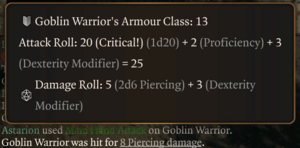Ad placeholder
Attacks
Attacks are attempts by a creature at hitting a target, usually with a weapon or a spell.
The outcome of an attempted attack is determined by the attacker making an attack roll against the target's AC. If the attempt is successful, the attack may deal damage or inflict a condition.
Attacks can be made by taking an Attack action, as well by taking any action that requires the attacker to make an attack roll.
Spell attacks are attack rolls made as part of casting a spell.
Attack rolls
When making an attack, a creature rolls a d20 and add the relevant ability score modifier to the results. If the attacker has proficiency with the weapon they make the attack with, or if the attack is made as part of a spell, they add their proficiency bonus to the result as well.[note 1]
The result of the attack roll is then compared against the target's Armour Class (AC). If the result was equal to or greater then the target AC, the attack is a hit, and roll for damage. If the result was less than the target AC, the attack was a miss.
Rolling a 1 is considered a critical miss, and is always considered a miss, regardless of the final results of the roll. Likewise, rolling a 20 is considered a critical hit – an automatic hit that deals additional damage.
Critical hits
Critical hits automatically hit the target (they never miss), and the attacker rolls twice the normal number of dice to determine damage dealt, including additional dice such as those from smites or combat manoeuvres. Modifiers and bonuses – including the creature's relevant ability score modifier and proficiency bonus – are not doubled.
Some equipment, feats and class features allow a creature to score a critical hit on natural rolls of 19 or 20, or even 18 to 20. The benefits are the same as for a regular critical hit. Some feats, class features, and items reduce the critical hit threshold by 1, allowing the creature to land critical hits by rolling 19 or higher on attack rolls. Multiple sources of this effect stack, allowing the critical hit threshold to go even lower than 19.
Some conditions, such as and , automatically turn all incoming attacks into critical hits.
Modifiers
Weapons
Melee and ranged weapon attacks use Strength or Dexterity, depending on the weapon: usually Strength for melee weapons and Dexterity for ranged weapons. The exceptions to this rule are Finesse weapons, which automatically select Strength or Dexterity, whichever score is higher; and Thrown weapons, which use Strength for both melee and ranged attacks. If a weapon is both Thrown and Finesse, it uses the higher of Strength and Dexterity for both melee and ranged attacks.
Some examples, to make the possible combinations of Finesse and Thrown easier to understand:
- Using a Maul for a melee attack always uses Strength.
- Using a Rapier (Finesse) for a melee attack uses Strength or Dexterity; whichever the attacking creature has a higher score in.
- Shooting a Longbow for a ranged attack always uses Dexterity.
- Throwing a Handaxe (Thrown) for a ranged attack uses Strength.
- Throwing a Dagger (Finesse & Thrown) for a ranged attack uses Strength or Dexterity, whichever is higher.
Spells
For spells, the Ability Score used for the Modifier depends on the class of the caster:
|
|
|
|
In Baldur's Gate 3, the same ability modifiers apply when casting a spell from a Scroll, even when the spell being cast is not normally available to your class. For instance, a Sorcerer casting ![]() Guiding Bolt (a Cleric-only spell) from a scroll adds its Charisma modifier to the Attack Roll of the spell.
Guiding Bolt (a Cleric-only spell) from a scroll adds its Charisma modifier to the Attack Roll of the spell.
Value of the Modifier
Whichever Ability Score ends up being used, the bonus or penalty value is based on this table, depending on how high the used Ability Score is:
| Ability score | Modifier value | Ability score | Modifier value | |
|---|---|---|---|---|
| 1 | -5 | 16-17 | +3 | |
| 2-3 | -4 | 18-19 | +4 | |
| 4-5 | -3 | 20-21 | +5 | |
| 6-7 | -2 | 22-23 | +6 | |
| 8-9 | -1 | 24-25 | +7 | |
| 10-11 | +0 | 26-27 | +8 | |
| 12-13 | +1 | 28-29 | +9 | |
| 14-15 | +2 | 30 | +10 |
Proficiency Bonus
The attacking creature's Proficiency Bonus is added to the result of the roll if the creature has the correct kind of Proficiency for the attack it's making.
For weapon attacks, the creature must have proficiency with the weapon it is using to make the attack. For spell attacks, every creature is automatically proficient.
The value of the bonus depends on the attacking creature's Level:
| Level | Proficiency Bonus |
|---|---|
| 1 to 4 | + 2 |
| 5 to 8 | + 3 |
| 9 to 12 | + 4 |
Footnotes
- ↑ Like all rolls made using a d20 die, attack rolls are affected by
 Advantage/
Advantage/ Disadvantage.
Disadvantage.
